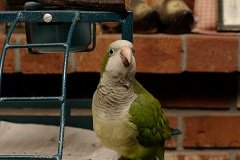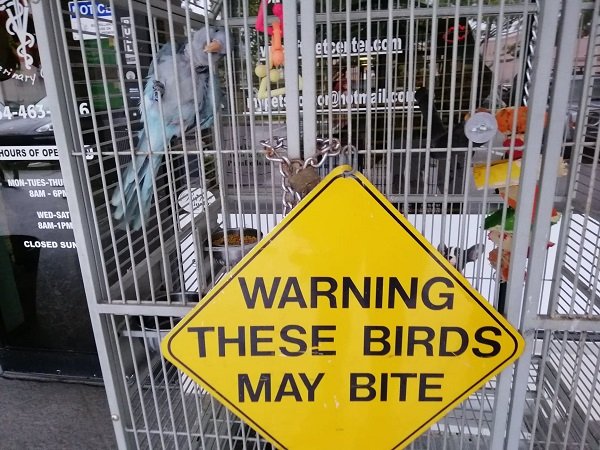Widely kept as pets, due to their excellent talking abilities, quaker parrots rank in the top 10 list of talking birds in the world. They are super-intelligent species and highly social beings enjoying the company of their owners if bonded well with.
As a quaker parrot’s owner, you need to provide proper training to your little new family member just the way we all do with human babies. When you welcome one home, be prepared to develop a good bond with him by devoting sufficient time for his learning sessions. You need to prepare him for the beautiful life that you have in store for him.
Getting Quaker parrot accommodated
First thing first, you need to train Quaker parrot for basic survival activities. After providing a comfortable place for him, let him explore his food dishes, water pot, and get accustomed to his new home.
Give him some time and space for adjusting to this new environment before proceeding to any interaction with your new companion. Initially, keep observing the parrot from a distance to check if he can carry out his survival tasks of eating and drinking properly. Help him, only if required, without entering into his personal space.

Beginning of the training
After a day of comforting the bird, you can start training him for other activities. If you have brought home a baby quaker parrot, it will be easier for you to train him as he is in his brain-development stage of life.
In case you have a rescued one or an older one to train, you will be required to devote more time and energy to teach him and remain extremely patient during all the training sessions.

The most important thing to consider while training the quaker parrot is the bond that you develop with him from the very first day. You need to win his trust and let him know your intentions of not hurting him.
He might see you as a predator and run away from you if this is his first human interaction or due to any adverse situation he has faced in his past. As soon as you win over his trust, he will start listening to your instructions and will try his best to learn what you have to offer in your training sessions.
To win his confidence, start keeping his cage near you while you are performing your daily chores and sing soft songs or rhymes around him without directly looking at him. This will get him interested in you since quaker parrots are curious little creatures and are lovers of music.
Finger hop training
Once your Quaker parrot becomes comfortable with you, you can start teaching him the technique of stepping-up. You need to teach your pet to hop onto your finger or hand for this. Stepping-up is a natural instinct for parrots as they hop from perch to perch.
For making a stronger bond with your little one, you must train him to step-up onto your finger or hand on receiving an instruction from you. You can choose a word like ‘come’ or ‘step-up’ or ‘let’s go’ for providing a verbal cue to your parrot while extending your hand or your index finger in front of him.
He might bite you in the beginning as he won’t be able to understand your intentions the very first time. Keep trying by uttering the same words and extending the same finger/hand until he steps onto it. Once he gets used to this technique of hopping onto your hand, teach him to hop from one of your hands to another with the same hop-on verbal cue. Make him practice this technique until he masters it completely.

Stick Training
The next part of your pet’s training shall include stick-training. It is pretty much similar to the step-up technique we just talked about. The only difference is that your hand is replaced by a stick or a dowel.
Try adding different shapes and sizes of the stick as part of the training. It is essential to teach your pet to step-up on a very long stick during these stick-training sessions. You can rescue him from a high spot with a long stick easily, in case any such need arises. Once your pet parrot learns to step-up onto the stick properly and has enough practice, train him to hop onto your hand from the stick.

Training Quaker Parrot to Talk
Training your parrot to speak words and sing, is what we all inspire to achieve. For utilizing the talking abilities of your little pet and his love for music, start uttering the same words in front of him in every training session until he starts repeating them in an efficient manner.
Train him to repeat these words in a particular situation like greet him with a ‘Hello’ every time you enter his room so that he starts saying it himself after a few days on your arrival. Make sure that not only the word but also the tone of the word remains the same every time you speak it in front of him because your pet will not only copy the word but also the tone of it.
You can start by teaching him a set of basic words like hello, bye-bye, thank you, love you and then expand their vocabulary by introducing a few words at a time. Don’t forget to test the words he has done learning with, from time to time.
For the singing training, the easiest method is to sing rhymes in front of him in the tone you want him to learn them. Once he starts picking up the rhymes, teach him your favorite songs by the same repetition method.
Quaker parrot playing with other birds
You can also train your quaker parrot to bond with a new bird you just brought home, or a bird from your neighborhood. For the first few interactions of these birds, do not share their cage or keep their cages close enough to harm each other.
Place their cages at a distance and let them decide whether they want to befriend each other or not. After a few such meetings, if you observe a calmness in their behavior while being in the same room, you can shorten the distance between their cages for developing a comfort level with each other.
When they start bonding well, they can be allowed to share the cage maintaining a proper space inside the cage for both the birds to avoid any territorial issues. Please do not leave your parrot without your supervision when he shares the cage with the other bird for the very first time.

Quaker parrot Potty training 🙂
You must have heard about potty-training for pet dogs but were you aware of the fact that you can potty-train your pet parrot too! It is a little difficult task in case of birds but as birds are habitual beings, they can definitely be trained for this if we make it a habit for them to do the job at a particular place.
For training your parrot to pass the poop at a specific place, you need to give him physical as well as verbal instructions at the same time. Whenever your pet is about to do the job, keep a plate under him to catch the poop and give verbal instructions like ‘poop away’.
With time, he will start understanding that he is not allowed to do it anywhere except the plate. You can then keep that plate in the cage itself. As your parrot relates that plate to potty, he will fly to it to release the poop himself.
Train quaker parrot anything…
This way, you can train your parrot for anything that can be taught with the help of a repetition technique. Make him learn a new bird trick you just saw over the internet or introduce him to a bird harness and encourage him to wear it for his safety. With the harness on, you can take him to outdoor excursions and explore nature together. Life can be much more rewarding with such outdoor trips with our pets.
Training tips:
- A pro tip for making your training sessions easier would be using a ‘reward and punishment’ technique with your Quaker parrot. Your pet needs encouragement for developing good habits and for learning something new. You can reward him either with a food treat that he loves the most or with your special attention to such good behavior. Also, it is important to punish your little one for bad behavior. An effective punishment can be in the form of ignoring him when he is behaving in a bad manner. This way, he won’t be encouraged to repeat that behavior due to the lack of attention it received.
- During the training period, it is advisable to spend as much time with your parrot as you plan to spend on the days after the training is over. Since parrots are habitual beings, they will start expecting you more, if you devote more of your time to them in the beginning. The main aim of your training should revolve around bringing out your parrot’s individuality and making him a good pet at the same time.


